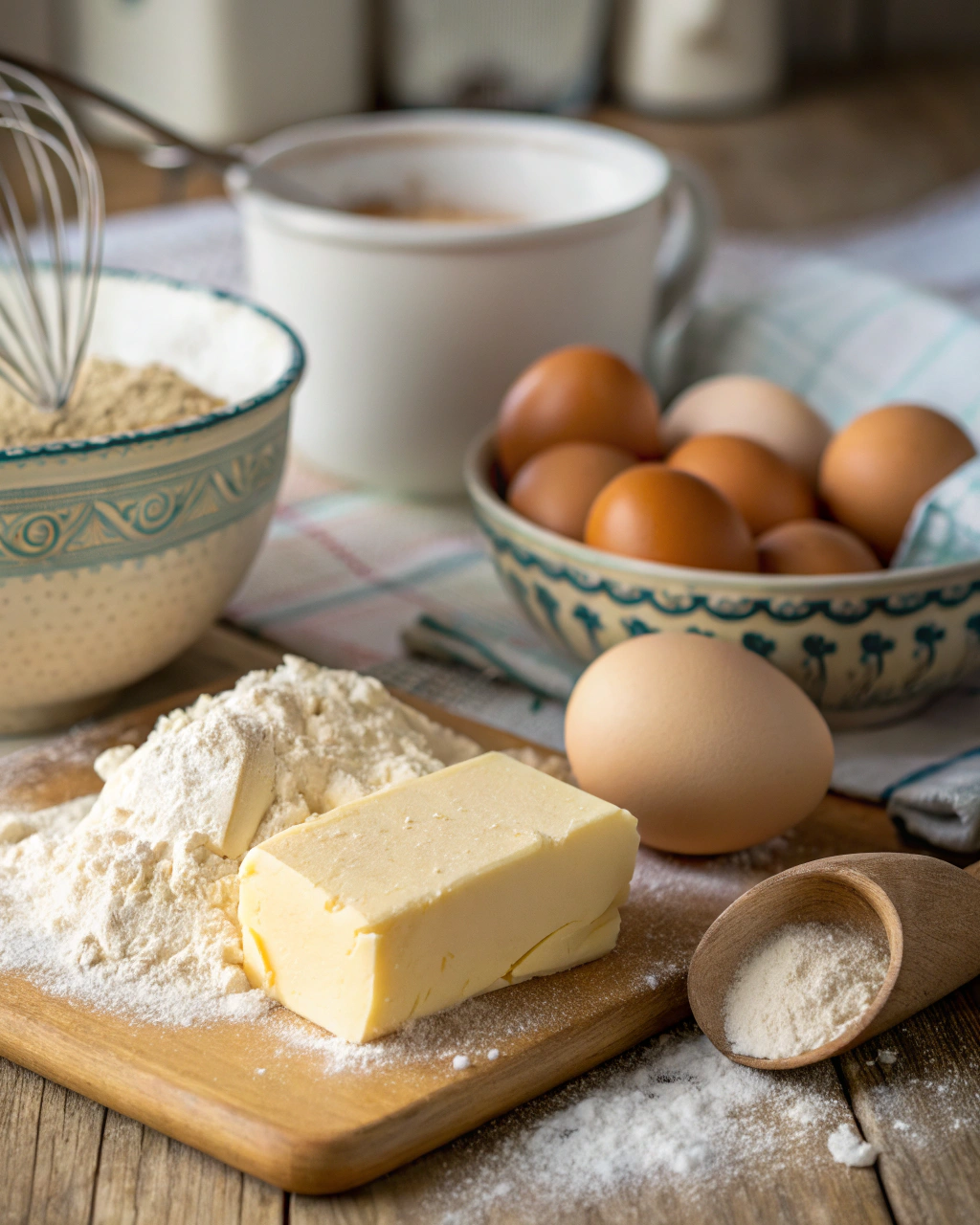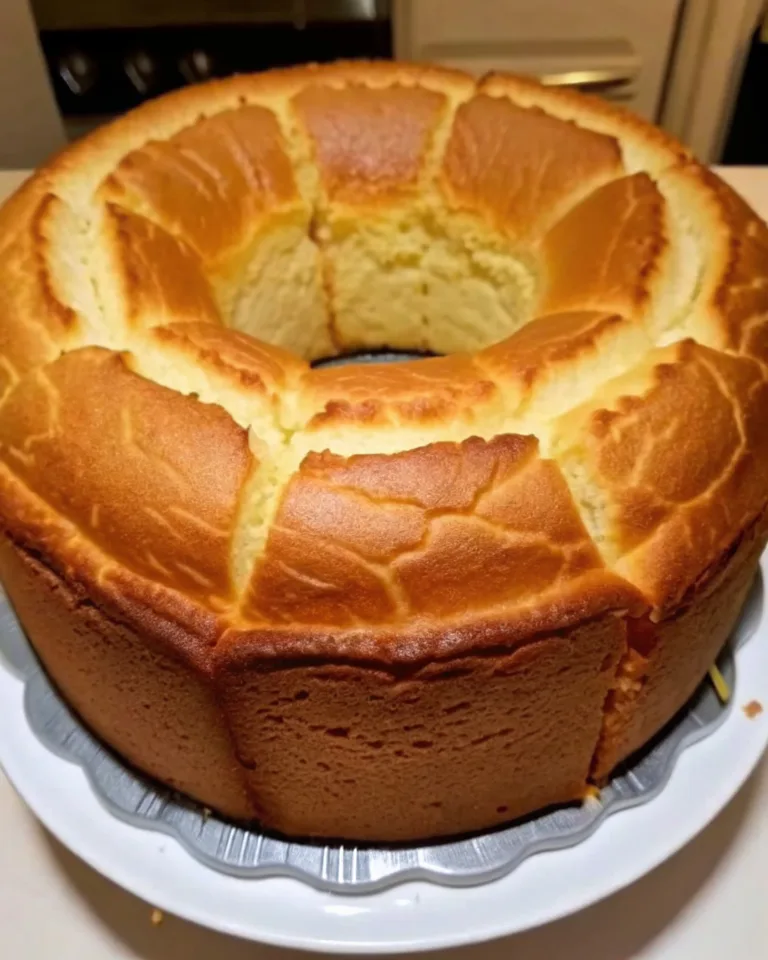The kitchen window fogged as the intoxicating aroma of my grandmother’s buttermilk pound cake filled our farmhouse on those crisp Sunday afternoons. That dense, velvety crumb and golden crust became the backdrop of my childhood – a slice of buttermilk pound cake meant comfort had arrived. According to a Southern Living survey, pound cake remains among the top three most beloved desserts across the American South, with buttermilk variations specifically mentioned by 68% of respondents as their family’s go-to recipe. What makes this humble cake so enduringly popular, and how can you create the perfect buttermilk pound cake in your own kitchen?
The perfect buttermilk pound cake balances simplicity with sublime texture – tangy yet sweet, moist yet structured, and versatile enough to complement almost any occasion from casual afternoon tea to elegant dinner finales. This Southern classic has stood the test of time because it delivers consistent comfort with minimal fuss.
Exploring the origins of buttermilk pound cake reveals fascinating historical connections. The traditional pound cake emerged in 18th century Europe as an easily remembered formula of equal pound measurements. When Southern bakers incorporated 19th Century buttermilk baking techniques, they transformed the basic recipe into something magical. Today’s variations include delightful twists like Homemade Strawberry Cream Cheese Pound Cake or the equally delicious Classic Vanilla Butter Cake for those seeking alternatives to buttermilk.
Why Buttermilk Makes the Ultimate Pound Cake
Buttermilk works true magic in pound cake. The acidity tenderizes the gluten, producing a finer crumb while interacting with leavening agents to create perfect rise. Unlike standard pound cakes made with regular milk, buttermilk pound cake develops a distinctive tang that cuts through the sweetness, creating a more sophisticated flavor profile.
The acid in buttermilk also breaks down long protein strands that can make cakes tough. This chemical reaction is what gives buttermilk pound cake that melt-in-your-mouth quality that’s impossible to achieve with regular milk. Professional bakers frequently choose buttermilk as their secret weapon for creating cakes with superior texture and keeping qualities.
Ingredients for Perfect Buttermilk Pound Cake
Buttermilk Pound Cake Ingredients
- 3 cups all-purpose flour
- 1/2 teaspoon baking soda
- 1/2 teaspoon salt
- 1 cup (2 sticks) unsalted butter, softened
- 3 cups granulated sugar
- 6 large eggs, room temperature
- 1 cup buttermilk, room temperature
- 2 teaspoons pure vanilla extract
- 1 teaspoon lemon zest (optional but recommended)
Each ingredient in this buttermilk pound cake plays a vital role in creating that perfect texture and flavor. If you need substitutions, cake flour can replace all-purpose flour for an even more delicate crumb, while Greek yogurt thinned with a bit of milk works in place of buttermilk. Unsalted butter is preferred, but if using salted butter, simply omit the additional salt.
Ingredient Spotlight
Buttermilk: The star of our show provides tanginess while its acidity activates the baking soda, creating lift and tenderness. Real buttermilk (not just milk with lemon juice) contains cultures that contribute to the cake’s distinctive flavor profile.
Room Temperature Ingredients: This isn’t just baking snobbery! Room temperature butter creates more air pockets when creamed with sugar, while room temperature eggs and buttermilk incorporate more smoothly, preventing the batter from curdling and ensuring an even rise.
Vanilla Extract: Pure vanilla extract provides depth of flavor that complements the tanginess of buttermilk. The alcohol in extract evaporates during baking, leaving behind concentrated vanilla flavor compounds that enhance every bite.
Lemon Zest: These tiny flecks contain aromatic oils that brighten the entire cake. The citrus notes don’t make the cake taste lemony—they heighten the buttermilk’s tang while adding complexity.
Timing
- Preparation: 25 minutes
- Baking: 75-85 minutes
- Cooling: 2 hours
- Total Time: Approximately 4 hours
While this might seem lengthy compared to quick bread recipes that require only 90 minutes total, the extended baking and cooling periods are essential for proper structure. Buttermilk pound cake develops its signature texture during the slow, even baking process—rushing will result in a dense, gummy center. Most professional bakers agree that proper cooling is essential; pound cakes cut while warm often appear underbaked.
Instructions for Buttermilk Pound Cake
Step 1: Prepare Your Pan and Oven
Preheat your oven to 325°F (165°C). Thoroughly grease and flour a 10-inch tube pan or Bundt pan, ensuring every crevice is covered. For guaranteed easy release, I create a paste of 1 tablespoon flour mixed with 1 tablespoon shortening and apply with a pastry brush—a trick I learned from my grandmother that has never failed me.
Step 2: Combine Dry Ingredients
In a medium bowl, whisk together the flour, baking soda, and salt. This uniform distribution prevents bitter baking soda pockets in your finished buttermilk pound cake. Sifting these ingredients creates an even lighter texture by incorporating air and removing lumps.
Step 3: Cream Butter and Sugar
In a large mixing bowl, beat the softened butter at medium speed until creamy and lightened in color (about 1-2 minutes). Gradually add the sugar, about 1/4 cup at a time, beating for 30 seconds between additions. Continue beating for 5-7 minutes total until the mixture is noticeably lighter in both color and texture. This extended creaming process creates millions of tiny air pockets that will expand during baking.
Step 4: Add Eggs
Add eggs one at a time, beating for 30 seconds after each addition. The gradual incorporation prevents the mixture from curdling, which can happen if cold eggs hit softened butter too quickly. After all eggs are incorporated, scrape down the sides and bottom of the bowl.
Step 5: Alternate Dry Ingredients and Buttermilk
Beginning and ending with the flour mixture, add the dry ingredients and buttermilk in alternating portions (flour-buttermilk-flour-buttermilk-flour). Mix on low speed just until incorporated after each addition. This method prevents overmixing and ensures proper hydration of the flour proteins.
Step 6: Add Flavorings
Gently fold in the vanilla extract and lemon zest just until distributed. Overmixing at this stage can develop too much gluten, resulting in a tough cake rather than the tender buttermilk pound cake we’re aiming for.
Step 7: Bake with Care
Pour the batter into the prepared pan, smoothing the top with a spatula. Tap the pan gently on the counter 2-3 times to release any large air bubbles. Bake in the preheated oven for 75-85 minutes, or until a wooden skewer inserted near the center comes out with a few moist crumbs (not wet batter).
Step 8: Cool Properly
Allow the buttermilk pound cake to cool in the pan on a wire rack for 15 minutes. Then invert onto the rack and remove the pan, letting the cake cool completely (about 2 hours) before slicing. Proper cooling solidifies the crumb structure and enhances both texture and flavor.
Tips & Tricks for Perfect Buttermilk Pound Cake
The Butter Test: If your finger leaves a slight impression in the butter when pressed, it’s at the perfect temperature for creaming. Too soft and you’ll incorporate less air; too firm and it won’t cream properly.
Sugar Gradual Addition: Adding sugar slowly to butter creates a finer crystal structure that supports the cake during baking. Professional bakers time this process carefully—approximately 30 seconds between each addition.
The Flour Shield: When measuring flour, spoon it lightly into measuring cups and level with a knife. Scooping directly from the container compacts flour, resulting in up to 25% more than the recipe calls for—a common cause of dry buttermilk pound cake.
The Oven Thermometer Truth: Most home ovens are off by 25-50 degrees. An inexpensive oven thermometer ensures your buttermilk pound cake bakes at the precise temperature required for optimal rise and moisture retention.
The Foil Strategy: If the top begins browning too quickly, loosely tent with aluminum foil after about 45 minutes of baking. This prevents a burnt exterior while allowing the interior to bake completely.
Recipe Variations & Substitutions
Lemon Buttermilk Pound Cake: Increase lemon zest to 1 tablespoon and add 2 tablespoons fresh lemon juice. Create a glaze with 1 cup powdered sugar mixed with 2 tablespoons lemon juice.
Chocolate Buttermilk Pound Cake: Reduce flour to 2 3/4 cups and add 1/2 cup Dutch-processed cocoa powder to the dry ingredients. Add 1/4 teaspoon espresso powder to enhance the chocolate flavor.
Gluten-Free Buttermilk Pound Cake: Replace all-purpose flour with a high-quality cup-for-cup gluten-free flour blend. Add 1/2 teaspoon xanthan gum if your blend doesn’t already include it and increase buttermilk by 2 tablespoons.
Reduced-Sugar Buttermilk Pound Cake: Cut sugar to 2 cups and add an extra teaspoon of vanilla for flavor enhancement. The texture will be slightly less moist, but still delicious.
Behind the Recipe
This buttermilk pound cake recipe has been in my family for four generations, passed down from my great-grandmother who ran a small bakery in rural Georgia during the 1930s. She claimed the recipe came to her in a dream, though family lore suggests she won it in a church baking competition from a reluctant competitor.
What makes this recipe special isn’t just its perfect balance of ingredients, but the techniques refined over decades. My grandmother insisted on room temperature ingredients and precisely timed mixing—methods I initially thought fussy until I began baking professionally and realized how scientifically sound her instructions were.
Each time I make this buttermilk pound cake, I’m transported back to that farmhouse kitchen where patience was considered the most important ingredient of all.
Pairing Ideas
Buttermilk pound cake shines when paired with:
- Fresh berries macerated with a touch of sugar
- Whipped cream infused with a hint of maple syrup
- Warm fruit compote (peach, cherry, or mixed berry)
- Coffee with a splash of cream
- Hot tea (Earl Grey or English Breakfast)
- Sparkling water with citrus
- Fresh mint-infused lemonade
Leftover & Reuse Ideas
Buttermilk pound cake arguably tastes better on day two as flavors meld. Beyond simple slicing, try these creative ways to use leftovers:
- Toast slices until golden and top with fruit compote for breakfast
- Cube and layer with pudding and fruit for a quick trifle
- Create French toast by dipping slices in an egg-milk mixture and pan-frying
- Crumble over ice cream for a decadent dessert
- Process into crumbs and use as a pie or cheesecake crust
Nutritional Information
A standard slice of buttermilk pound cake (1/16 of recipe) contains approximately:
- Calories: 365
- Fat: 15g
- Carbohydrates: 56g
- Protein: 5g
- Sodium: 145mg
Serving Suggestions
For casual gatherings, serve thick slices on vintage-inspired dessert plates with a light dusting of powdered sugar. For more formal occasions, try thin slices arranged in a fan pattern with fresh berries and a small dollop of whipped cream.
For afternoon tea, cut the buttermilk pound cake into finger-sized rectangles and serve alongside fruit skewers. At brunch, try toasting slices lightly and offering a selection of fruit preserves for spreading.
Common Mistakes to Avoid
Cold Ingredients: Using cold butter, eggs, or buttermilk creates a lumpy batter that won’t trap air properly during baking. Always bring ingredients to room temperature (about 1 hour on the counter).
Overmixing After Flour Addition: Excessive mixing develops gluten, creating a tough rather than tender buttermilk pound cake. Mix just until ingredients are incorporated after adding flour.
Inaccurate Measurements: Baking is chemistry. Using volume rather than weight measurements can lead to significant inconsistencies. If possible, use a kitchen scale for precision.
Oven Temperature Fluctuations: Opening the oven door frequently causes temperature drops that prevent proper rising. Resist checking before the 60-minute mark.
Insufficient Cooling: Cutting into warm buttermilk pound cake causes it to compress and appear underbaked. Always allow the full cooling time for perfect texture.
Storage & Reheating Tips
Room Temperature: Store completely cooled buttermilk pound cake under a cake dome or wrapped in plastic wrap at room temperature for up to 3 days.
Refrigeration: For longer storage (up to 1 week), wrap tightly in plastic wrap and refrigerate. Return to room temperature before serving for best texture.
Freezing: Buttermilk pound cake freezes beautifully for up to 3 months. Wrap individual slices or the entire cake in plastic wrap, then aluminum foil. Thaw overnight in the refrigerator, then bring to room temperature before serving.
Refreshing: To revive slightly stale cake, microwave individual slices for 10-15 seconds or place in a 300°F oven for 5 minutes.
FAQs About Buttermilk Pound Cake
Why did my buttermilk pound cake fall in the center?
Cake falling usually indicates underbaking or opening the oven door too early in the baking process. The structure needs time to set before being exposed to temperature changes.
Can I make buttermilk pound cake without real buttermilk?
While you can substitute regular milk mixed with 1 tablespoon vinegar or lemon juice per cup, real buttermilk provides superior flavor and texture due to its cultured properties and specific fat content.
How do I know when my buttermilk pound cake is perfectly done?
A wooden skewer inserted into the center should come out with a few moist crumbs but no wet batter. The top should spring back when lightly touched, and the edges should just begin pulling away from the pan.
Can buttermilk pound cake be made in advance for special occasions?
Yes! Buttermilk pound cake actually improves in flavor after 24 hours as the ingredients meld. It’s an ideal make-ahead dessert that reduces day-of preparation stress.
Why is my buttermilk pound cake dense instead of fluffy?
Dense texture usually results from undermixing the butter and sugar (not enough air incorporated), overmixing after adding flour (developing too much gluten), or inaccurate measurements (too much flour or not enough leavening).
The Timeless Appeal of Buttermilk Pound Cake
From Sunday suppers to celebration centerpieces, the buttermilk pound cake remains a testament to the beauty of simple, quality ingredients transformed through careful technique. Its versatility makes it appropriate for any occasion, while its familiar comfort brings people together around the table.
The tang of buttermilk, the richness of butter, and the delicate sweetness create a perfect trinity of flavor that has stood the test of time. By following these detailed instructions and incorporating these professional tips, you’ll create a buttermilk pound cake worthy of becoming your own family tradition.
Made these Buttermilk Pound Cake? Drop your twist in the comments, rate the recipe, and tag us on facebook, instagram with #erinrecipes — we might feature your creation!
Print
Buttermilk Pound Cake: How to Bake the Perfect Southern Classic
- Total Time: 1 hour 35 minutes
- Yield: 12 slices 1x
- Diet: Vegetarian
Description
This Buttermilk Pound Cake is a classic dessert with a tender crumb, buttery flavor, and a hint of tang from buttermilk. Perfectly simple yet irresistibly delicious, it’s a timeless treat that’s great for any occasion.
Ingredients
- 1 cup unsalted butter, softened
- 2½ cups granulated sugar
- 4 large eggs
- 1 tsp vanilla extract
- 3 cups all-purpose flour
- ½ tsp baking soda
- ½ tsp salt
- 1 cup buttermilk
- Optional: powdered sugar for dusting
Instructions
- Preheat and Prepare: Preheat oven to 325°F (165°C). Grease and flour a 10-inch bundt or tube pan thoroughly.
- Cream Butter and Sugar: In a large bowl, cream the butter and sugar together for 4–5 minutes until light and fluffy. This step is crucial for creating a tender texture.
- Add Eggs and Vanilla: Add the eggs one at a time, mixing well after each addition. Stir in vanilla extract for flavor.
- Mix Dry Ingredients: In a separate bowl, whisk together flour, baking soda, and salt.
- Combine Wet and Dry Ingredients: Add the dry ingredients to the wet mixture in three parts, alternating with buttermilk. Mix until just combined—do not overbeat, as this can make the cake dense.
- Pour Batter: Pour the batter evenly into the prepared pan and smooth the top with a spatula.
- Bake: Bake for 70–80 minutes, or until a toothpick inserted into the center comes out clean. If the cake browns too quickly, cover loosely with foil halfway through baking.
- Cool: Let the cake cool in the pan for 15 minutes, then invert onto a wire rack to cool completely.
- Serve: Dust with powdered sugar before serving if desired. Slice and enjoy!
Notes
Substitutions: Use Greek yogurt mixed with milk as a substitute for buttermilk. For a richer flavor, add a teaspoon of almond extract along with the vanilla. Store leftovers in an airtight container at room temperature for up to 3 days.
- Prep Time: 20 minutes
- Cook Time: 75 minutes
- Category: Dessert
- Method: Baking
- Cuisine: American
Nutrition
- Serving Size: 1 slice
- Calories: 460
- Sugar: 30g
- Sodium: 150mg
- Fat: 20g
- Saturated Fat: 12g
- Unsaturated Fat: 7g
- Trans Fat: 0g
- Carbohydrates: 60g
- Fiber: 1g
- Protein: 5g
- Cholesterol: 90mg
Keywords: buttermilk pound cake, classic pound cake, easy cake recipe, buttery dessert

